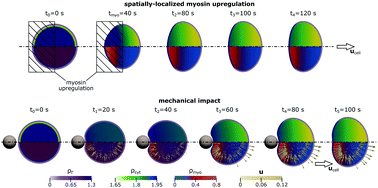Influence of myosin activity and mechanical impact on keratocyte polarization†
Abstract
In cell migration, polarization is the process by which a stationary cell breaks symmetry and initiates motion. Although a lot is known about the mechanisms involved in cell polarization, the role played by myosin contraction remains unclear. In addition, cell polarization by mechanical impact has received little attention. Here, we study the influence of myosin activity on cell polarization and the initiation of motion induced by mechanical cues using a computational model for keratocytes. The model accounts for cell deformation, the dynamics of myosin and the signaling protein RhoA (a member of the Rho GTPases family), as well as the forces acting on the actomyosin network. Our results show that the attainment of a steady polarized state depends on the strength of myosin down- or up-regulation and that myosin upregulation favors cell polarization. Our results also confirm the existence of a threshold level for cell polarization, which is determined by the level of polarization of the Rho GTPases at the time the external stimuli vanish. In all, this paper shows that capturing the interactions between the signaling proteins (Rho GTPases for keratocytes) and the compounds of the motile machinery in a moving cell is crucial to study cell polarization.



 Please wait while we load your content...
Please wait while we load your content...